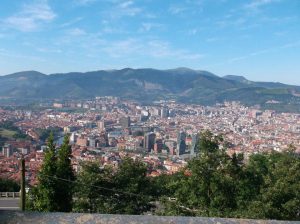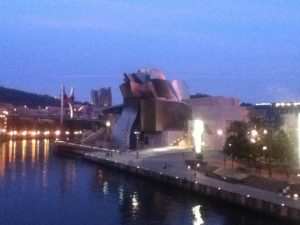 Ten years ago, while reading an article about the Basque independent terrorist group ETA (Euskadi Ta Askatasuna, or Basque Country Freedom), I thought to myself, “If I ever go to Spain, I’ll never visit the Basque Country. Terrorists groups and rain. Who would want to go there?”
Ten years ago, while reading an article about the Basque independent terrorist group ETA (Euskadi Ta Askatasuna, or Basque Country Freedom), I thought to myself, “If I ever go to Spain, I’ll never visit the Basque Country. Terrorists groups and rain. Who would want to go there?”
Ten years later, I’m eating my words as I happen to call this enchanting, drizzly place home. I couldn’t be located in a more beautiful part of the Iberian Peninsula. ETA called a ceasefire in 2011 and has kept their word. The most danger I have felt while living here is riding a bike in the street where there aren’t any bike lanes on one of the many rainy days.
Even though the Basque Country is one of 17 autonomous communities that make up Spain, the Basques have their own separate language (Euskera) and culture. They are just as adamant as the Catalans about their lack of Spanishness, despite the fact that the Spanish language is just as common here as Spanish tortilla and soccer.
In 2010, I traveled to this magical place for the first time. My first stop was San Sebastián in Spanish, or Donostia as it’s known in Basque.
 Twenty kilometers from the French border, Donosti, as it’s known to the multitude of people who have fallen in love with it, is known for having one of the most beautiful beaches in Spain (“La Concha”, or The Shell), its film festival every September, and for its pintxos, the gastronomical delight of the Basques. While the southern part of the peninsula has “tapas”, small servings of food given free with its drinks, pintxos are a bit bigger, tastier and pricier. Accompanied by a “txakoli” (a white wine from the Basque Country) or “kalimotxo” (wine and Coke), pintxos make the most discerning foodie content.
Twenty kilometers from the French border, Donosti, as it’s known to the multitude of people who have fallen in love with it, is known for having one of the most beautiful beaches in Spain (“La Concha”, or The Shell), its film festival every September, and for its pintxos, the gastronomical delight of the Basques. While the southern part of the peninsula has “tapas”, small servings of food given free with its drinks, pintxos are a bit bigger, tastier and pricier. Accompanied by a “txakoli” (a white wine from the Basque Country) or “kalimotxo” (wine and Coke), pintxos make the most discerning foodie content.
I have returned to Donosti several times since, every time falling more in love with its enchanting old quarter sandwiched between two beaches. I joke that despite the typical Basque rain, I have only been there when it is 21ºC (around 70ºF) and sunny. That might be because I will only go on sunny days now.
 In Donosti, a walk along the Concha to “El Peine del viento” (the Comb of the Wind) sculpture is a must. It’s a forty minute stroll that offers spectacular views of the beach and the city that takes you to a sculpture on rocks jutting out into the sea. Another must is the walk around Mount Urgell that offers views of the crashing waves, or a hike up the mountain to the Sacred Heart of Jesus statue for spectacular views from the statue and old castle.
In Donosti, a walk along the Concha to “El Peine del viento” (the Comb of the Wind) sculpture is a must. It’s a forty minute stroll that offers spectacular views of the beach and the city that takes you to a sculpture on rocks jutting out into the sea. Another must is the walk around Mount Urgell that offers views of the crashing waves, or a hike up the mountain to the Sacred Heart of Jesus statue for spectacular views from the statue and old castle.
 Although I feel Donosti is the more beautiful of the Basque cities, I think its rival, Bilbao, is the better place to live. The locals are a bit friendlier, and the villages and countryside surrounding the “village” of 350,000 people are charming and quaint. It offers a bit of something for everyone. While having the typical pintxos and wine of the Basque Country, Bilbao also offers many other types of restaurants for every type of palette.
Although I feel Donosti is the more beautiful of the Basque cities, I think its rival, Bilbao, is the better place to live. The locals are a bit friendlier, and the villages and countryside surrounding the “village” of 350,000 people are charming and quaint. It offers a bit of something for everyone. While having the typical pintxos and wine of the Basque Country, Bilbao also offers many other types of restaurants for every type of palette.
Bilbao was also recently named on BusinessInsider.com’s recent “100 Trips Everyone Should Take in Their Lifetime”, although despite what the article says, everyone who lives here knows that the Guggenheim Museum is not even close to being the most interesting place to see here.
 Of course, when I ask my students if the Basque Country has any famous places, the first thing everyone says is the Guggenheim. Built in the 1990s, it is Bilbao’s pride and joy. I went once on its anniversary, when admission is free instead of 13€. The art is abstract and very modern. For traditional art lovers, the cheaper, less famous Museum of Bella Artes is a better bet.
Of course, when I ask my students if the Basque Country has any famous places, the first thing everyone says is the Guggenheim. Built in the 1990s, it is Bilbao’s pride and joy. I went once on its anniversary, when admission is free instead of 13€. The art is abstract and very modern. For traditional art lovers, the cheaper, less famous Museum of Bella Artes is a better bet.
The coolest neighbourhood of Bilbao is the Casco Viejo with its “Seven Streets,” which even a Bilbao native can lose themselves in. The labyrinth of streets is home to all kinds of shops, bars, cafés, nightlife (including several gay bars) and activity. The Unamuno Plaza is home to two museums, the Basque Museum and the Basque Archeological Museum. It also offers the stairs to the best park in the city, Extebarria, which offers views of the entire city and allows dogs a place to play. By the way, the Basques are very dog-friendly. My flatmate’s German Shepherd likes to visit bars and is welcome in most of them.
Bilbao is also home to an estuary with fancy bridges, including my favorite, the Calatrava-designed “Zubizuri”. Since Bilbao was an industrial center for so many years before reinventing itself in the 1990s as a service-oriented city, the Nervion River leaves a lot to be desired. However, it does provide a nice place to walk, run, skate or ride your bike in the bike lanes.
The new San Mames soccer stadium, still under construction, is also recommended by nearly every student. Soccer is the most popular sport here, and the Athletic de Bilbao soccer squad is beloved by nearly every citizen of Bilbao. They are currently having a good season, in fourth place and destined for Champions. They are one of three Spanish teams that has never lowered to Second Division. The other two are, of course, Real Madrid and Barcelona. Even if you don’t speak Basque (which to be honest, few people do even in Bilbao), greeting someone with Aupa Athletic will make you fast friends with the Bilbao citizens.
For the nature lovers like me, Bilbao offers plenty. From the city center, you can take the cable car to Artxanda for the best views of the city. On a clear day, you can also see the sea. For the hikers, Bilbao is on the Northern route of the Camino de Santiago. I’ve already conquered Pagasarri, the highest peak of Bilbao at 673 metres. Gorbea, the highest peak of the Vizcaya, awaits me. At the moment, it’s been the only Basque mountain that has snow.
Bilbao’s metropolitan area includes Portugalete and Getxo. Getxo is home of the rich and not-so famous, and several beaches, but the “Puente Colgante” that connects the two over the Nervion belongs to Portugalete. For the small fee of 35 cents, you can cross the river next to cars and other people by the ferry hanging from the top of the bridge. It is a UNESCO World Heritage site.
 For me, the most stunning place in the Basque Country is San Juan de Gaztelugatxe, an old church located on an island, reached only by a bridge with 210 stairs. I’ve been twice, and both times, I felt as if I were on the Great Wall of China with waves crashing up against the bridge. I rang the church bell 13 times both visits, although I still have headaches. Ringing the bell is said to stop them, but it is also said that the rain in Spain falls mainly on the plain. The Basque Country is far from being the plain.
For me, the most stunning place in the Basque Country is San Juan de Gaztelugatxe, an old church located on an island, reached only by a bridge with 210 stairs. I’ve been twice, and both times, I felt as if I were on the Great Wall of China with waves crashing up against the bridge. I rang the church bell 13 times both visits, although I still have headaches. Ringing the bell is said to stop them, but it is also said that the rain in Spain falls mainly on the plain. The Basque Country is far from being the plain.
There are many other fascinating places to visit outside Donosti and Bilbao. You might want to check out Gernika (Guernica), the village bombed during the Spanish Civil War that inspired Picasso’s famous painting, or Bosque de Oma, a painted forest. There’s also the Seaside villages including Mundaka (one of the best surfing places in the world due to its left-breaking waves), Bermeo, Orio, Ondarroa, Lekeitio, Zarautz, Deba and Hondarribia. And don’t overlook the Basque capital city of Vitoria-Gasteiz, the “green capital” of the world, which offers a medieval Old Town and many bike paths.
The proximity of sea and mountains make Bilbao one of the best places to live. Sure, it may rain a lot, but no place is perfect.
Spain is known for bullfighting, fiestas, siestas, sangria, and sun. The north in general challenges this notion, and it gives a welcome respite to the tourist developments in the south. While it is far from the typical Spanish experience so many want, the Basque experience offers its own unique flavor.
Just remember to pack the umbrella along with your sunscreen, as you will probably need both several times in the same day.
For further information about the history of the Basques, be sure to check out The Basque History of the World: The Story of a Nation by Mark Kulansky.
——
Photo Credit: all photos by Pablo Allen Haker
[box type=”bio”]
 PAUL ALLEN HAKER, Pablo to his friends, is a thirtysomething English teacher and writer who lives in Bilbao in the Basque Country in northern Spain. Constantly searching for deeper meaning in life, Pablo spends most of money on travelling and learning language (he speaks English, Spanish, Catalan, Italian and is currently trying his hand at Basque). When he’s not teaching, at the gym, travelling or watching films, he can be found working on his novel or reading at a café. Keep up with his current writing at his blog, Señor Brightside.
PAUL ALLEN HAKER, Pablo to his friends, is a thirtysomething English teacher and writer who lives in Bilbao in the Basque Country in northern Spain. Constantly searching for deeper meaning in life, Pablo spends most of money on travelling and learning language (he speaks English, Spanish, Catalan, Italian and is currently trying his hand at Basque). When he’s not teaching, at the gym, travelling or watching films, he can be found working on his novel or reading at a café. Keep up with his current writing at his blog, Señor Brightside.
[/box]




